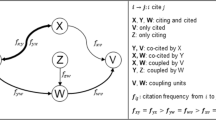Abstract
Co-citation analysis is one of the most important methods in information science. Journal co-citation analysis has been widely used to analyze the relevance, relationship and structure of underlying articles between journals. Accurate construction of co-citation matrix is a key to accurate journal co-citation analysis. However, the traditional co-citation matrix construction based on co-citation frequency of journals does not accurately reflect the similarity between journals. This paper proposes a new construction method of co-citation matrix based on the number of co-citation articles in journals. The experimental validation has been conducted with real datasets from Chinese Social Science Citation Index and National Knowledge Infrastructure. The results show that the proposed method can accurately capture the similarity between journals and outperform the existing approaches (i.e. co-citation frequency and co-citation ratio approaches). In addition, the proposed method does not need the full-text index of a paper, which provides added value in the field.




Similar content being viewed by others
References
Bu, Y., Ni, Sh K, & Huang, W. B. (2017). Combining multiple scholarly relationships with author cocitation analysis: A preliminary exploration on improving knowledge domain mappings. Journal of Informetrics, 11(3), 810–822.
Eto, M. (2013). Evaluations of context-based co-citation Searching. Scientometrics, 94(2), 651–673.
Gipp, B. & Beel, J. (2009). Identifying related documents for research paper recommender by CPA and COA. In Proceedings of international conference on education and information technology. Berkeley: International Association of Engineers, pp. 636–639.
He, L. R. (2005). Analysis on correlative tendency of frequency of cited journals or impact factor and article counts. Chinese Journal of Scientific and Technical Periodicals, 16(4), 500–503.
Huang, L. P. (2011). Literature aging research based on citation analysis: An analysis in library and information science and management science. Journal of Intelligence, 30(10), 30–35.
Jeong, Y. K., Song, M., & Ding, Y. (2014). Content-based author co-citation analysis. Journal of Informetrics, 8(1), 197–211.
Leydesdorff, L., & Vaughan, L. (2006). Co-occurrence matrices and their applications in information science: Extending ACA to the web environment. Journal of the American Society for Information Science and Technology, 57(12), 1616–1628.
Liu, Sh B, & Chen, Ch M. (2012). The proximity of co-citation. Scientometrics, 91(2), 495–511.
Liu, Sh B, Zhang, Ch B, Ding, K., & Liu, Z. Y. (2013). The improvement of co-citation analysis based on the citation context and citation position. Journal of the China Society for Scientific and Technical Information, 32(12), 1248–1255.
Marshakova, I. V. (1973). System of document connections based on references. Scientific and Technical Information Serial of VINITI, 6(2), 3–8.
McCain, K. W. (1990). Mapping authors in intellectual space: A technical overview. Journal of the American society for information science, 41(6), 433–443.
Mongeon, P., & Paul-Hus, A. (2016). The journal coverage of web of science and scopus: A comparative analysis. Scientometrics, 106(1), 213–228.
Qin, Ch J. (2010). The empirical research of the knowledge domains map between subject relationship based on journal co-citation analysis method. Journal of Modern Information, 5, 9–11.
Qiu, J. P., & Li, J. P. (2009). The co-citation analysis of the Journal of Library and Information Science. Information Studies: Theory & Application, 39(2), 17–19.
Qiu, J. P., Ma, R. M., & Li, Y. J. (2008). Reconsiderations on co-citation analysis. Journal of the China Society for Scientific and Technical Information, 27(1), 69–74.
Small, H. (1973). Co-citation in the scientific literature: A new measure of the relationship between two documents. Journal of American Society for Information Science, 24(4), 265–269.
Susana, S. G., Juan, G., & David, M. F. (2018). Reference density trends in the major disciplines. Journal of Informetrics, 12(1), 42–58.
van Veller, M. G. P., & Gerritsma, W. (2015). Development of a journal recommendation tool based upon co-citation analysis of journals cited in Wageningen UR research articles. Qualitative and Quantitative Methods in Libraries, 4(2), 233–257.
Waltman, L., van Eck, N. J., van Leeuwen, T. N., & Visser, M. S. (2013). Some modifications to the SNIP journal impact indicator? Journal of Informetrics, 7(2), 272–285.
Wang, X. W., & Liu, Z. Y. (2009). Study on journal classification based on co-citation ratio analysis. Science Research Management, 30(5), 187–195.
White, H. D., & Griffith, B. C. (1981). Author cocitation: A literature measure of intellectual structure. Journal of the American Society for Information Science, 32(3), 163–171.
Acknowledgements
We would like to acknowledge the support of China Fund for the Humanities and Social Sciences (No. 11CTQ027). The authors would like to thank the anonymous reviewers and the editor, who provided constructive comments on the earlier version of this paper.
Author information
Authors and Affiliations
Contributions
Lijun Yang: Conceived and designed the analysis, collected the data, contributed data or analysis tools, performed the analysis, wrote the paper. Liangxiu Han: Conceived and designed the analysis, collected the data, contributed data or analysis tools, performed the analysis, wrote the paper. Naxin Liu: Conceived and designed the analysis, collected the data, contributed data or analysis tools, performed the analysis, wrote the paper.
Corresponding author
Rights and permissions
About this article
Cite this article
Yang, L., Han, L. & Liu, N. A new approach to journal co-citation matrix construction based on the number of co-cited articles in journals. Scientometrics 120, 507–517 (2019). https://doi.org/10.1007/s11192-019-03141-9
Received:
Published:
Issue Date:
DOI: https://doi.org/10.1007/s11192-019-03141-9




